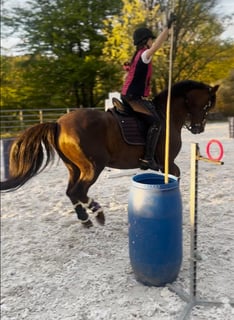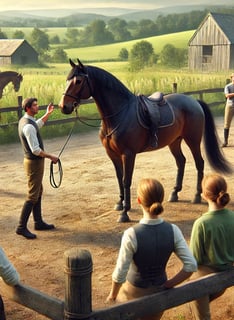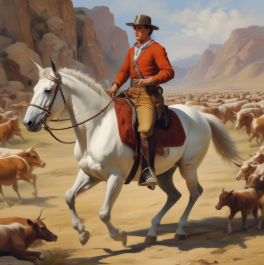

The proud discipline of Working Equitation
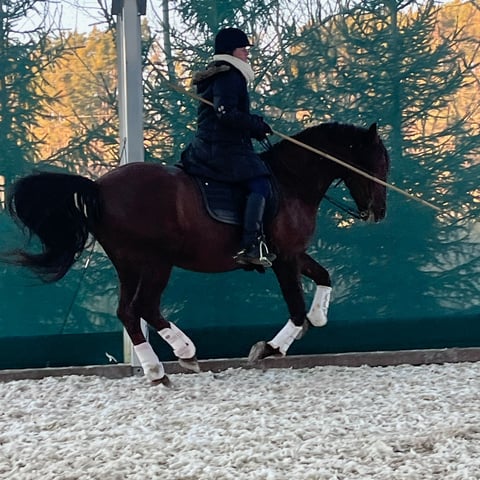

The fascinating world of Working Equitation

History and tradition united with a modern sport: The story of Working Equitation's origins.
Four disciplines in one
The competitive format of Working Equitation combines four different disciplines: dressage, obstacle work, speed test, and cattle handling. Each part tests different skills of both the rider and the horse, making this sport highly complex and demanding.
The Importance of Riding Harmony
In Working Equitation, there is a strong emphasis on the harmony between the rider and the horse. The horse should perform all tasks with ease and willingness, which is prioritized in this sport.
Rise in Popularity
Although the discipline was only formalized in the 1990s, today Working Equitation is one of the fastest-growing equestrian sports in the world. It has spread to many countries, and there are now international competitions, including world championships.
Versatility of Horses
This discipline does not require horses specialized in a single task. On the contrary, horses must be versatile and capable of performing various tasks at a high level. This makes Working Equitation appealing to a wide range of riding breeds and increases its attractiveness among breeders.
Global Popularity
Today, Working Equitation is popular not only in the countries of its origin but has spread to other parts of the world, including North and South America, Australia, and Central Europe. The discipline is gaining followers among riders of various specializations because it combines tradition, technique, and practical skills with elegance and sporting challenge.
Different Traditions in Various Countries
Although Working Equitation originated from Spanish and Portuguese traditions, it has developed with certain differences in various countries. For example, in Italy, there is an emphasis on elegance and aesthetics, while in Portugal and Spain, the focus is on cattle work and practicality.
One-Handed Control of the Horse
One of the key skills a rider must master in Working Equitation is the ability to control the horse with one hand. This skill comes from historical riding techniques, where the rider needed one hand free to work with tools or manage cattle. It requires a high level of control and coordination, as the rider must maintain balance while guiding the horse effectively with minimal rein pressure. This aspect of the sport highlights the importance of a strong, subtle connection between horse and rider.
Original inspiration
Working Equitation was inspired by traditional skills that were essential for everyday farm work, such as controlling cattle or working with horses in challenging terrain conditions. In the past, riders used techniques that were purely practical, but over time, they began to evolve into a form of sport discipline.
Deep traditions
Working with horses is one of the oldest and most important forms of cooperation between humans and animals, dating back thousands of years. Horses were initially used for heavy work in the fields, transportation, but primarily in cattle handling, which was a daily necessity in many countries. In these historical periods, when mechanization did not exist, the horse was an indispensable helper and a vital partner for survival.
In the Mediterranean, particularly in Spain and Portugal, specific equestrian techniques for efficient cattle handling began to develop. These skills formed the foundation for daily work on farms and ranches. The rider and the horse became an inseparable team capable of performing various tasks on the pastures, such as controlling herds or working on steep slopes.
In Italy and France, where the need for fast and efficient horse handling was important not only for agriculture but also for military purposes, other forms of work developed that focused on precision and agility. Horses were used for transportation and transport, but also as invaluable assistants in protecting and organizing large estates and properties.
As technology evolved over time and horses ceased to be the exclusive helpers in everyday work, these traditions and techniques were preserved to prevent them from fading. Traditional equestrian skills became part of the cultural heritage, continuing in the form of various formal competitions and training methods.
The history of working with horses is therefore not just a story of hard labor, but also a tale of the incredible relationship between humans and animals that has shaped the cultural and practical aspects of life for millennia, continuing to this day.
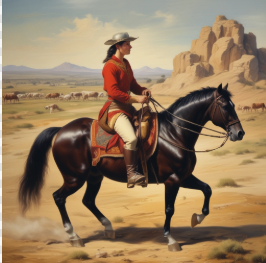

The History of the Origins of Working Equitation: The Art of Versatility in the Saddle
Working Equitation is a relatively young equestrian discipline, yet it draws heavily from the deep traditions of working horsemanship across various countries. Its roots primarily lie in Southern Europe, where the skill of controlling the horse with one hand while working with cattle has been developed for centuries. The most significant influences on the formation of the discipline came from the equestrian cultures of Spain, Portugal, Italy, and France, where mastery in horsemanship was passed down from generation to generation.
The modern form of Working Equitation was established in 1996 when enthusiasts decided to formalize these traditional skills into a competitive format. The goal was not only to preserve historical techniques but also to allow riders of different styles to compare their abilities in a unified competition format. The competition consists of four parts: a dressage test, an obstacle course test of maneuverability, a speed test, and cattle handling. Each phase emphasizes precision, ease, and harmony between the horse and rider.



